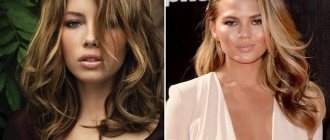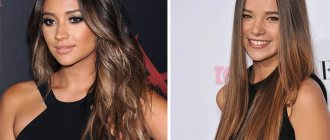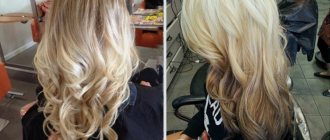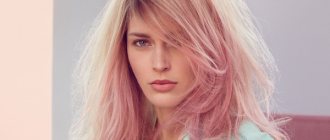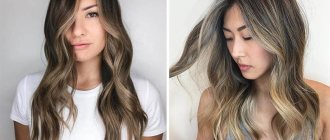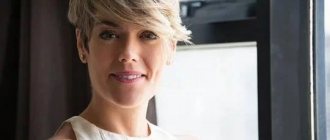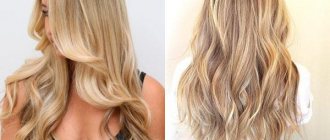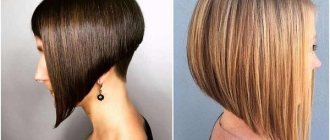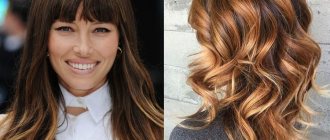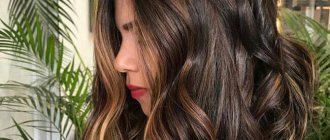Who is it suitable for?
Reverse highlighting is a strand-by-strand application of a dark dye that is as close as possible to the natural shade of the curls. This type of coloring is great for hairstyles of different types and lengths.
Of course, such highlighting looks most impressive on long, light curls.
It is worth noting that the procedure is excellent for women who have previously constantly lightened their hair. If the regrown roots look unattractive, reverse highlighting is a real salvation in this case.
The procedure can be used in the following cases:
they took too long and did not make the correction on time;- when lightening is done on most of the hair;
- if the hairdresser does not comply with the proportions of the haircut;
- urgent need to correct the shade;
- correct coloring that did not match the color type or was not to your liking.
The reverse highlighting technique allows you to grow a natural color without dyeing the entire mass of hair that is damaged or weakened by constant exposure to chemicals. This technique helps disguise growing roots.
Shampoo for toning

The easiest way to give your hair a new shade is to use this shampoo. If we look at examples of such coloring, then in the photo the highlights with tinting with shampoo are not much different from those where tinting paints were used.
Another property of such a product is that it is impossible to achieve a clear color. You can only add a slight tint, and therefore you should not choose colors that are very different from the original color of the curls.
You should not use this shampoo more often than once every seven days. This is especially true for highlighted hair, because it is the most vulnerable to damage. If you adhere to such a schedule, then over time the color will become saturated, since in this case the accumulation effect works.
When there is no desire for rich color, then twice a month is enough.
In addition, girls have seen highlighting without tinting more than once in their lives and in photos; it has a yellow tint. To get rid of it, use special neutralizing tinted shampoos.
Today, many cosmetic companies produce toning products. Among them:
- Tonic from Rocolor. She has nine colors in her palette for both blondes and brunettes. The series also includes a yellow neutralizer.
- Irida M. This shampoo was developed by a Russian company and has a large selection of shades. The budget price (up to seventy rubles) also makes it very attractive.
- Life Color. Product from the manufacturer of professional cosmetics Kapus. Despite its purpose, it has a fairly lasting effect. There are five shades in the palette, but this pleasure costs around three hundred and fifty rubles.
- There are shampoos that do not betray the shade, but only mask the yellow pigment. These include Schwartskopf, Estelle, Londa and others.
You may be interested in:Clavicle haircut: who is it suitable for, features of implementation, unusual ideas, photos
By the way, before purchasing a tinting shampoo, you should read the instructions. If the composition contains sulfates, then it is better to look for another product. Due to the high concentration of sulfates, hair can fall out, break and dry out.
Advantages and disadvantages
First of all, let's look at the positive aspects:
- very gentle effect, in contrast to direct highlighting, when you have to apply a lightener to the strands;
- the ability to correct unsuccessful bleaching, or apply spectacular bright highlights to light hair;
- a way to grow hair of a natural color, without affecting the entire volume of hair with new dyes.
Disadvantages of the procedure:
- Over time, the dye is washed off and the hair acquires a bleached shade;
- the procedure takes a long time;
- difficult to perform at home with the highest quality results.
For light brown and dark hair
As you know, highlighting is the easiest to do on light brown hair, but it is more difficult to choose the right color. There are practically no colors that are unsuitable for light brown, but based on the girl’s color type, it may not be the most successful. Reverse highlighting perfectly corrects this misunderstanding, as a way to correct other people's mistakes.
As you can see, during reverse highlighting for a light brown color, you can even change the shade of the treated strands by several tones, and this will be least noticeable.
For dark hair, colors such as chestnut, brown, brunette or dark blond are most often used for restoration; these are the most neutral and flattering colors; they can easily cover even unsuccessful highlights.
And now that the photos have been reviewed, it’s time to start the video tutorials:
How to choose the right shade?

As a rule, the hairdresser chooses the paint based on the lightness of the roots on the back of the head, but a darker color can be allowed, but no more than 2 tones from the natural one.
For fair-haired girls of the winter-summer type (cold color type), you can use the following shades:
- light brown;
- straw;
- all shades of brown;
- dark blond;
- cognac and honey.
Important! With this color type, you should not use red, copper, black, red - such a hairstyle will look very vulgar. Yellowness on curls is also not allowed.
If the color type is spring-autumn, then you should use the following palette:
- chestnut;
- dark brown;
- redhead;
- reddish;
- copper;
- bronze;
- sandalwood.
Duration of results and further care
The procedure should be carried out frequently, ideally every month. This is necessary so that there are no overgrown roots when there is a difference between your own color and the chosen one.
In addition, it is very difficult to choose the right shade if more than 3 months have passed since dyeing.
As for care, it requires the application of nourishing masks, the use of shampoo and conditioner for colored hair.
It is important to resort to heat treatment less often. Protective varnishes and gels are used for styling. A special gel fluid is suitable for care. It will get rid of split ends, help comb your hair, and protect it.
Technique and execution scheme
Reverse highlighting is carried out in the same way as direct highlighting, with the difference that the strands are not lightened, but painted in dark shades. The algorithm of actions is as follows:
- Prepare everything needed for painting.
- Divide the bulk of hair into sections.
- Separate the strands and apply paint along the entire length, as with regular highlighting.
- Apply bleach to the roots of the adjacent strand.
- Dye your entire hair in a similar way and leave for 35-45 minutes.
- Wash off the paint with shampoo and apply conditioner.
The width of the curls that should be dyed and the need to dye the hair roots is selected based on the type of hairstyle and the desired result. Some women thus highlight dark areas on light areas, others resort to similar dyeing in order to make their hair color even.
Important! It is better not to carry out such coloring at home, since a positive result requires an exact match of the color, and only an experienced master can do this.
Step-by-step instructions for the procedure
Exposure time
The duration of exposure must be determined in each specific case individually. It depends on the desired level of color, lightening, hair structure, dye features, instructions.
- For dark and thick hair, the exposure time is longer - up to 40 minutes.
- For light and fine hair, the procedure lasts 20 minutes.
You cannot overexpose the paint; it is important to follow the instructions and recommendations of the manufacturers.
Practical advice
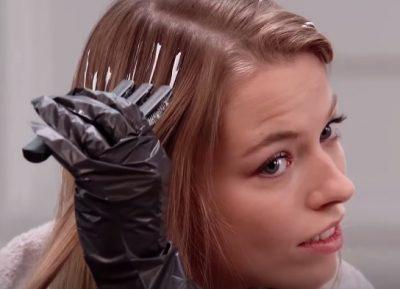
You need to highlight unclean hair; it is better that at least 2 days pass after washing.
The curls are thoroughly combed and divided into zones: crown, back of the head and parietal. The dyeing process starts from the back of the head. From there it gradually moves up, forward and sideways. Finally, the top layers are processed.
Stages of staining:
- hair is divided into sections and then into strands.
- Using paint selected to match the natural shade, the first strand is processed along its entire length.
- The next curl is painted with a natural tone only near the roots.
- Next, a curl is taken and colored from the root zone with a light shade.
- During the procedure, curls need to be alternated: along the length/near the roots.
- Each strand is covered with foil or paper cut in the shape of a square.
- The effect of the composition depends on the brand of paint - on average 30-40 minutes.
How to pick up strands
To begin with, all hair is divided into sections, and then into curls. The recruitment technique is selected based on the desired effect. Most often - a veil or darning.
The use of darning allows you to achieve the effect of uniform shade. The veil will give a clear distinction between light and dark tones.
- For the darning technique, a wide strand of hair is taken, from which the necessary strands are collected using movements similar to darning with a needle. If you choose shades that differ greatly in depth of tone, then the strands should be thin, otherwise you will get the effect of a raccoon tail rather than highlights.
- Using the veil technique, only hair from the curls on the outside of the hairstyle is dyed. The hair on the top of the head should not be dyed; the bleached curls should be visible through the natural shade. The strands are first separated at the top of the head, then a thin strand (3-4 mm) is taken with a comb, onto which a coloring compound is applied and covered with foil. Hair is lightened along a line or in a circle. Then you need to skip 1-2 cm of hair layer and repeat the lightening process again.
Recommendations for highlighting short haircuts
For short hair, you will need a special cap with holes in a checkerboard pattern and a hook for pulling out curls. You need to do this:
- comb your hair and put on a hat.
- Determine the modeling step and pull the curls into all the holes to create a general background and intense coloring (the main color for the hair roots).
- To obtain medium color intensity, curls are pulled into every second hole. For light highlights - every third.
- Only now the dye is prepared and applied to the hair. The duration of exposure is determined individually, it all depends on the structure of the hair and the brand of dye. Approximately 15-30 minutes. If the hair is dark and thick – 40 minutes.
- The composition is washed off until the water is clear.

We talked in more detail about the intricacies of highlighting through a cap here.
What's best for medium hair?
The method using rubber bands is suitable for medium-length hair. At the base the hair will turn out darker. Such coloring not only helps to refresh the look, but also to play with color.
The procedure requires rubber bands. The hair is divided into zones along the parting. Small tails are attached to each one. To obtain fashionable “feathers”, paint is applied to the tips.
Tips for coloring long strands
The most suitable option for highlighting long hair is to use foil.
But here it is important to note that the use of food foil can cause it to slide off the strands, and this is unacceptable with reverse highlighting. Therefore, you should invest in special foil or paper.
Photos before and after
Below you can see photos before and after the procedure:
How to fix a bad color
Sometimes there are episodes when the highlighting turned out to be absolutely terrible, the strands are uneven, yellow, and even strange spots near the roots. What to do in this case?
It is best to completely recolor your hair . However, this is not as easy to do as it seems, because due to the heterogeneity of the color, the new color will settle into the strands in different shades. How to avoid worsening results?
In some salons, to correct reverse highlighting, they first suggest dyeing the lightest strands in darker tones, thereby evening out the color, and only then dyeing the hair in a different shade.
Who better not to do it?
There are certain times when reverse highlighting can greatly harm your appearance:
- If the strands were dyed with henna, the color will turn out dirty.
- After curling your curls using various chemicals, the result will be unpredictable.
- Brittle weakened strands. Hair that is over-dried by constant lightening will look unsightly with reverse highlighting.
- Irritation on the scalp - if this problem is not dealt with before coloring, then simple irritation can turn into ulcers and sores.
It is also worth abandoning this type of coloring if the ends are severely damaged - reverse highlighting will highlight even the invisible imperfections of the hairstyle.
Reverse highlighting is a procedure that allows you not only to correct coloring that failed, but also to place certain color shades on your hair that emphasize the beauty of your curls - getting an updated look with minimal harm to your hair.
But it is worth considering that the paint washes out quite quickly during reverse highlighting, so in order for the effect to last as long as possible, you will have to take care of your hair very carefully and competently using professional products.
Benefits of tinting
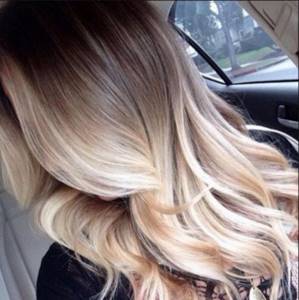
After the appearance has been changed, it is worth thinking about how to tint your hair after highlighting. It is best to choose tinting rather than full coloring, because it has many undeniable advantages:
- Toning does not harm the hair. This is because vitamins and minerals are added to tinting compositions, which can even eliminate some problems, for example, make the color more saturated, add shine to the hair and moisturize the curls.
- A big plus is that you can do tinting at home.
- The budget price also plays into the hands, because this procedure requires frequent repetition.
- Toning products have a wide palette, which means that any girl, regardless of hair color, will find a suitable shade in it.
- Tinting neutralizes the yellow tint that blondes often have to contend with.
- Tinting will also help blur the line between regrown and dyed hair.
- Hair tinting and highlighting are gentle methods of coloring, which means they have a minimum of contraindications.
- If you use the tint product constantly, the color will accumulate. This means that over time the hair will only become brighter.
- If you tint your hair after bleaching, your hair will suffer less damage than from dye.
- Since tinting is an unstable method of coloring, there will be no problems with changing the color.
- You can dye hair of any length.
- You can tint your hair at any age starting from sixteen years old.
